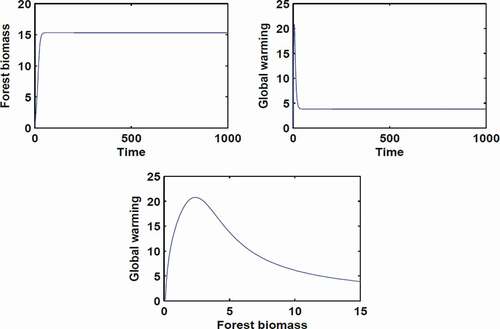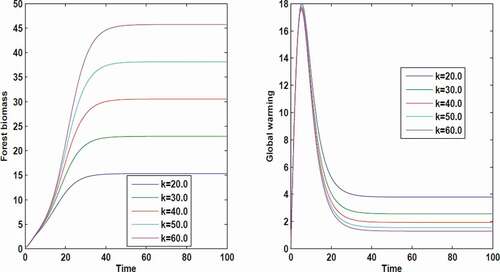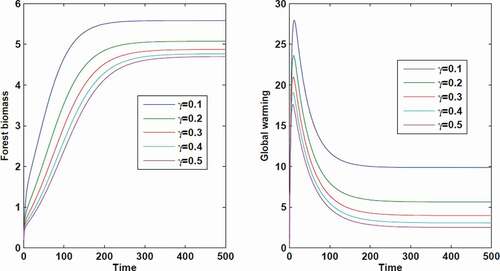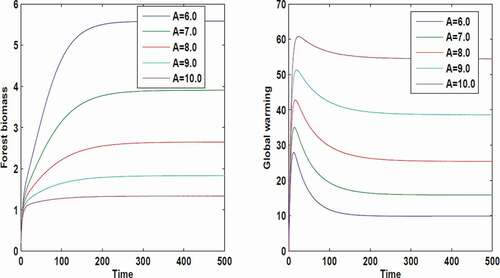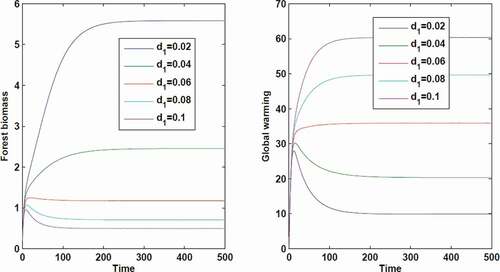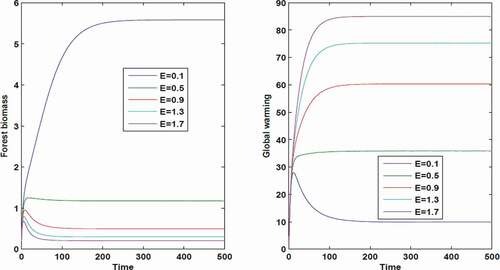 ?Mathematical formulae have been encoded as MathML and are displayed in this HTML version using MathJax in order to improve their display. Uncheck the box to turn MathJax off. This feature requires Javascript. Click on a formula to zoom.
?Mathematical formulae have been encoded as MathML and are displayed in this HTML version using MathJax in order to improve their display. Uncheck the box to turn MathJax off. This feature requires Javascript. Click on a formula to zoom.ABSTRACT
In this article, a mathematical model has been formulated by considering forest biomass and global warming as a separate compartment. It is assumed that the forest biomass follow logistic growth in the absence of global warming. It is also assumed that the growth of forest biomass is affected by global warming. It is considered that the density of forest biomass decreases due to natural burning of forests, cut down of forest biomass by human beings and continuous harvesting of forest biomass by human being. It is found that if we can increase the area of forest biomass then the rate of increase of global warming will be reduced. It is also found that if the harvesting rate of forest biomass increases, then global warming will be gradually increased. Finally, some numerical simulation results have been presented.
1. Introduction
Global warming is the increase of temperature of the Earth’s surface as well as its atmosphere. The study of Hansen et al. (Citation2010) suggests that the average temperature around the world have risen by 0.75 C over the last 100 years about two thirds of this increase has occurred since 1975. Sun et al. (Citation2019) investigated the impacts of global warming on health, wildfires and agricultural crops. In 2010, Casper (Citation2010) investigated the impacts of global warming on ecological systems. This study explored that the growth of forest biomass is influenced by global warming (https://www.climateandweather.net/global-warming/deforestation.html). Zhao et al. (Citation2019) investigated the negative effect of warming on plant biomass and ecosystem respiration in a Tibetan alpine steppe. Growth of wild animals and cultivated plant under global warming has been reported by Lippmann et al. (Citation2019). Paletto et al. (Citation2019) studied the effects of biomass power plants to increase the social acceptance of renewable energy technologies. Dudley (Citation1998) and Christianson (Citation1999) have investigated the potential impact of global warming on forest biomass. Again, it is known to all that a forest is a large area dominated by trees. Vogt Kristina et al. (Citation2007) studied the necessity of forest biomass for the existence of human beings and to maintain the ecological balance. Beauty of forest attracts tourists and also forest gives different things for human beings such as food, shelter, medicine etc. But the human activities such as continuous or unscientific harvesting can negatively affect on forest biomass (Li et al., Citation2019; Ontoria et al., Citation2019; Vogt Kristina et al., Citation2007). Pingoud et al. (Citation2012) investigated the potential factors of global warming and the effects of use of forest biomass. The impacts of Brazil’s forests sector to maintain global warming under Kyoto protocol has been studied by Fearnside (Citation2001). From the above literature survey, it is observed that global warming has a bad effect on human as well as forest biomass. Again, decrease rate of an area of forest biomass is responsible for global warming. In this situation, the study of the impacts of global warming on forest biomass is very much necessary for the existence of human beings.
There exist few research articles on the mathematical model of forest biomass. In 2009, Dubey et al. (Citation2009) investigated the impacts of human population pressure and rapid industrialization on forest biomass. Their study suggests that rapid increase of the human population and industrialization can destroy the forest habitat. It may increase the temperature of the atmosphere of the earth. Again in 2010, Agarwal et al. (Citation2010) developed a mathematical model to study the effects of industrialization on forest biomass. Their study claimed that in the absence of industrialization, the densities of the forest biomass and the wildlife species are high and when industrialization comes into play, forest biomass and wildlife species both settle down at lower densities. This shows that industrialization affects the biomass of the forest adversely, which in turn may cause harm to the wildlife species and also increase global warming. There are also some research papers (Shukla & Dubey, Citation1997; Shukla et al., Citation2011, Citation2009) on forest biomass, including the effects of population, pollution, toxicants and industrialization on forest biomass. These articles suggest that human population pressure, toxin release from different industry can destroy the forest biomass and may increase global temperature. Again, some researchers have been studied stability and dynamics of some mathematical models (Panja & Mondal, Citation2014, Citation2015; P. Panja et al., Citation2016, Citation2017, Citation2017a, Citation2017b; Mortoja Golam et al., Citation2018; P. Panja et al., Citation2018) related to ecological as well as epidemiological problems. Hinners et al. (Citation2019) investigated the impacts of phytoplankton on global warming. From the above literature survey, it is observed that global warming and forest biomass are dependent on each other. In this paper, our target is to explore different ecological effects and global warming on forest biomass.
The paper is organized as mathematical model is formulated in Section 2. Boundedness of all solutions of the proposed system is analyzed in Section 2.1. The existence of different equilibrium points and stability of the system around these points have been analyzed in Section 2.2. The optimal harvesting on forest biomass has been discussed in Section 2.3. We have presented some numerical simulation results and discussion in section 3. Finally, in last section we have presented some of the main outcomes of the present work.
2. Materials and methods
In this paper, our target is to find out the different possible impacts of global warming on the forest biomass. For this purpose, we have developed a nonlinear relational mathematical model of forest biomass and global warming. Let us assume that F(t) and G(t) be the density of forest biomass and global warming respectively. To formulate the mathematical model following assumptions have been made:
It is assumed that forest biomass grow logistically in the absence of global warming. Among the ecological effects of climate change are changes in the timing of natural events such as flowering. First changes in the timing of flowering influencing influence the conditions the plant will experience. For example, early flowering may increase the risk of forest damage in some plant species, which has a knock-on effect on seed production. Changes in phenology can also lead to mismatches between plants and pollinators (as a plant may no longer flower at the same time that bees are flying for example) with potentially drastic effects on reproduction(https://ec.europa.eu/info/energy-climate-change-environment). So, it is assumed that the growth rate of forest biomass is inversely proportional to the global warming or global climate change i.e.
.
Also, forest biomass decrease due to natural burning of forest and also cut down of forest by human beings for food, shelter and industrialization (Sahney et al., Citation2010; Henkel, Citation2015; https://www.livescience.com/63196-rainforest-facts.html). So we consider
depletion rate of forest biomass.
Again, it is known to all that humans benefited from the forest by harvesting woods, honey, different medicinal plants etc. (FAO yearbook of forest products, Citation2012.\\faoorg/foresty/statistics/80570/en/.FAO.). Here E is the harvesting rate of forest biomass.
The global warming on the earth surface and atmosphere constantly increases due to several human activities such as rapid increases of industrialization, urbanization, modern life style etc. (https://unfccc.int/news/rapid-urbanization-increases-climate-risk-for-billions-of-people). We have considered the constant increase rate A of global warming.
Again, different studies suggest that the global warming will be under control or decrease if human beings can take different possible control strategies such as plantation, decrease the use of fuel etc. (https://www.nrdc.org/issues/climate-change). Hence, we consider
depletion rate of global warming.
According to the above assumptions, we have formulated a set of nonlinear differential equations as follows:
which satisfies initial conditions F(0)>0 and G(0)>0. The parameters related to our proposed mathematical model are described in the following Table 1.
Table 1. Biological meaning of parameters
2.1. Boundedness of solutions
In this section, boundedness of all solutions of system (1) has been investigated.
Theorem 1. All solutions of system (1) are bounded.
Proof. From the last equation of system (1), we have
Now, using differential inequality (Birkhoff & Rota, Citation1982), it is obtained from equation (2) that
As , we have
.
Again, from the first equation of system (1), we have
Let us introduce a positive constant ξ, then we have
Let us take , then the maximum value of
is
. Then from the above equation, we can write
Therefore, applying differential inequality (Birkhoff & Rota, Citation1982), we have
As , it is obtained that
Hence all solutions of system (1) are bounded.
2.2. Equilibrium points and stability analysis
In this section, possible equilibrium points and stability of the system (1) are determined and discussed.
The system has following following equilibrium points:
The system has forest biomass free equilibrium point E1 = (0,
).
The system has coexisting equilibrium E* = (F*,G*) where G* =
and F* can be calculated from the equation
To discuss the stability of the system (1) around the equilibrium points, we first determine the jacobian matrix of the system (1) as follows:
where
Theorem 2. The forest biomass free equilibrium point is unstable.
Proof. The jacobian matrix at E1 is given by
The characteristic equation of the above jacobian matrix is given by
and the eigenvalues are
,
. Hence, using the stability theory, we can say that the forest biomass free equilibrium point is unstable.
Theorem 3. The coexisting equilibrium point is locally asymptotically stable if
Proof. The characteristic equation of the jacobian matrix at E* is given by
where ,
and
.
According to Routh-Hurwitch criteria, all the roots of the above characteristic equation will be negative if and
holds.
2.3. Optimal harvesting
In this section, we study the optimal harvesting policy by considering the profit earned by harvesting of some products collected from forests. Here the quadratic cost is used and the main reason behind this is to find the analytical expression for the optimal harvesting. It is assumed that the price is a function which is inversely proportional to the available biomass of forest biomass. Let h, p and w be the constant harvesting cost per unit effort, selling cost of unit biomass of forest biomass and economic constant. Thus to maximize the total discounted net revenues from the model, the optimal control problem can be formulated (Chakraborty et al., Citation2012; Jana et al., Citation2015) as follows:
where δ is the instantaneous annual discount rate. Here, the control E is bounded in and our target is to find out an optimal control E0 such that
where U is the control set defined by U = {E: E is measurable and
, for all t}. The problem (3) is solved by Pontryagin’s maximum principle (Pontryagin et al., Citation1962) subject to the initial condition system (1) and to optimize the objective function J(E), we construct the Hamiltonian $H$ as follows:
where and
are the adjoint variables and the transversality conditions are
Using the optimality condition , the optimal effort
can be obtained as follows:
Now, the adjoint equations are
3. Results and discussion
In this section, the dynamical behavior of our proposed model (1) has been discussed numerically using MATLAB. Due to unavailability of the real data of all parameters associated with the model, the hypothetical values for the different parameters have been considered as A = 6.0, r = 1.0, k = 20, = 0.02,
= 0.05,
= 0.1,
= 2.0,q = 0.4,E = 0.1. Using the above parametric values, has been drawn. From this figure, it is observed that forest biomass and global warming tend to the equilibrium level. Also, it is seen that as the forest biomass increases, then the global warming gradually decreases and ultimately goes to the equilibrium level.
Changing the value of the intrinsic growth rate r, the solution of a system (1) has been plotted in . From this figure, it is seen that if the intrinsic growth rate of forest biomass r increases, then the global warming is gradually decreasing. Hence, it can be concluded that if the plantation of forest increases, then the global warming may be under control. The solution of system (1) has been drawn in by changing the carrying capacity of forest biomass k. From this figure, it is observed that as the area of forest increases, then the global warming gradually decreases. So, it can be concluded that if the area of forest biomass increases, then global warming gradually decreases.
Taking different values of impacts rate of global warming in the growth of forest biomass γ, the solutions of system (1) has been plotted in . From this figure, it is observed that as the value of γ increases, then the growth rate of forest biomass gradually decreases. Hence, we can conclude that global warming has a great role in the growth of forest biomass.
Again, taking different values of recruitment rate of global warming A, has been drawn. From this figure, it is seen that as the value of A increases, then the growth rate of forest biomass gradually decreases. So, it can be concluded that if human continues different activities such as cut down of forest biomass, rapid industrialization, low quality of technology uses in the industry etc. then global warming gradually increases.
Also, considering different values of depletion rate of forest biomass has been drawn. From this figure, it is observed that if the depletion rate of forest biomass increase then the global warming gradually increases. So, from this figure, it can be concluded that the existence of sufficient amount of forest biomass is needed to control the global warming. Again, is drawn by taking different values of depletion rate of global warming
. From this figure, it is seen that if the depletion rate of global warming
is gradually increases then the forest biomass increases. Hence it can be concluded that the forest biomass increases due to the depletion rate of global warming. Finally, the solution of forest biomass and global warming have been plotted in by taking different harvesting rate E of forest biomass. From this figure, it is seen that if the harvesting of forest biomass increases then global warming gradually increases.
4. Conclusion
In this paper, a mathematical model of forest biomass and global warming has been developed. It is considered that the growth rate of forest biomass is inversely proportional to the global warming. Also, it is considered that forest biomass decrease due to natural burning, cut down of forest biomass by human beings and over harvesting of valuable plants from the forest by human beings. Boundedness of all solutions of system (1) has been investigated. Then different possible equilibrium points of our proposed system have been determined and the stability of the system around these equilibrium points has been investigated.
From the numerical simulation results of our proposed mathematical model, it is found that the interior equilibrium point is locally asymptotically stable (see ). Again, it is observed that if the growth rate of forest biomass increases, then global warming will be under control (see ). Also, it is observed that if the area of forest biomass increases, then global warming is gradually decreasing (see ). It is seen that if the impact rate of global warming in the growth of forest biomass increases, then the global warming gradually decreases (see ). Also, if global warming is constantly increases, then the forest biomass gradually decreases (see ). Again, it is seen that if human continues different activities such as cut down of forest biomass, rapid industrialization, low quality of technology uses in the industry etc. then global warming will gradually increase (see ). It is observed that the depletion rate of global warming gradually decreases due to plantation program (see ). Also, it is seen that if the harvesting of forest biomass increases, then the global warming gradually increases (see ). The present study can be extended by including human population in the model to study the effects of global warming on human population. Again, the present model can be extended by considering the parameters related to our proposed model as time dependent.
Disclosure statement
The author has no conflict of interests to publish this manuscript.
References
- Agarwal, M., Fatima, T., & Freedman, H. I. (2010). Depletion of forestry resource biomass due to industrialization pressure: A ratio-dependent mathematical model. Journal of Biological Dynamics, 4(4), 381–396. https://doi.org/https://doi.org/10.1080/17513750903326639
- Birkhoff, G., & Rota, G. C. (1982). Ordinray differential equations. Ginn.
- Casper, J. K. (2010). Changing ecosystems: Effects of global warming. An imprint of Infobase Publishing. Retrieved August, 28, 2017 from https://www.climateandweather.net/global-warming/deforestation.html
- Chakraborty, K., Jana, S., & Kar, T. K. (2012). Global dynamics and bifurcation in a stage structured prey-predator fishery model with harvesting. Applied Mathematics Computation, 218(18), 9271–9290. https://doi.org/https://doi.org/10.1016/j.amc.2012.03.005
- Christianson, G. (1999). Greenhouse: The 200-year story of global warming. Walker.
- Dubey, B., Sharma, S., Sinha, P., & Shukla, J. B. (2009). Modelling the depletion of forestry resources by population and population pressure augmented industrialization. Applied Mathematical Modelling, 33(7), 3002–3014. https://doi.org/https://doi.org/10.1016/j.apm.2008.10.028
- Dudley, N. (1998). Potential Impacts of Climate Change on Forests. A report for WWF International.
- FAO yearbook of forest products. 2012. faoorg/foresty/statistics/80570/en/.FAO. (Accessed on 22. 03.2018). https://unfccc.int/news/rapid-urbanization-increases-climate-risk-for-billions-of-people. Retrieved March 5, 2020, from https://www.nrdc.org/issues/climate-change
- Fearnside, P. M. (2001). The potential of Brazil’s forest sector for mitigating global warming under the kyoto protocol. Mitigation and Adaptation Strategies for Global Change, 6(3/4), 355–372. https://doi.org/https://doi.org/10.1023/A:1013379103245
- Hansen, J., Ruedy, R., Sato, M., & Lo, K. (2010). Global surface temperature change. Reviews of Geophysics, 48(4), RG4004. https://doi.org/https://doi.org/10.1029/2010RG000345
- Henkel, M. (2015). 21 st century homestead: sustainable agriculture III: agriculture practices. ISBN 9781312939752.
- Hinners, J., Hense, I., & Kremp, A. (2019). Modelling phytoplankton adaptation to global warming based on resurrection experiments. Ecological Modelling, 400, 27–33. Retrieved March 5, 2020, from https://ec.europa.eu/info/energy-climate-change-environment.
- Jana, S., Guria, S., Das, U., Kar, T. K., & Ghorai, A. (2015). Effect of harvesting and infection on predator in a prey-predator system. Nonlinear Dynamics, 81(1–2), 917–930. https://doi.org/https://doi.org/10.1007/s11071-015-2040-2
- Li, J., Dong, W., Oenema, O., Chen, T., Hu, C., Yuan, H., & Zhao, L. (2019). Irrigation reduces the negative effect of global warming on winter wheat yield and greenhouse gas intensity. Science of the Total Environment, 646, 290–299. https://doi.org/https://doi.org/10.1016/j.scitotenv.2018.07.296
- Lippmann, R., Babben, S., Menger, A., Delker, C., & Quint, M. (2019). Development of wild and cultivated plants under global warming conditions. Current Biology, 29(24), R1326–R1338. https://doi.org/https://doi.org/10.1016/j.cub.2019.10.016
- Mortoja Golam, S. K., Panja, P., & Mondal, S. K. (2018). Dynamics of a predator-prey model with stage-structure on both species and anti-predator behavior. Informatics in Medicine Unlocked, 10, 50–57. https://doi.org/https://doi.org/10.1016/j.imu.2017.12.004
- Ontoria, Y., Gonzalez-Guedes, E., Sanmart, N., Bernardeau-Esteller, J., Ruiz, J. M., Romero, J., & Prez, M. (2019). Interactive effects of global warming and eutrophication on a fast-growing mediterranean seagrass. Marine Environmental Research, 145, 27–38. https://doi.org/https://doi.org/10.1016/j.marenvres.2019.02.002
- Paletto, A., Bernardi, S., Pieratti, E., Teston, F., & Romagnoli, M. (2019). Assessment of environmental impact of biomass power plants to increase the social acceptance of renewable energy technologies. Heliyon, 5(7), e02070. https://doi.org/https://doi.org/10.1016/j.heliyon.2019.e02070
- Panja, P., & Mondal, S. K. (2014). A mathematical study on the spread of Cholera. South Asian Journal of Mathematics, 4(2), 69–84.
- Panja, P., & Mondal, S. K. (2015). Stability analysis of coexistence of three species prey-predator model. Nonlinear Dynamics, 81(1–2), 373–382. https://doi.org/https://doi.org/10.1007/s11071-015-1997-1
- Panja, P., Mondal, S. K., & Chattopadyay, J. (2016). Dynamics of cholera outbreak with bacteriophage and periodic rate of contact. International Journal of Dynamics and Control, 4(3), 284–292. https://doi.org/https://doi.org/10.1007/s40435-015-0196-8
- Panja, P., Mondal, S. K., & Chattopadyay, J. (2017a). Dynamical effects of anti-predator behaviour of adult prey in a predator-prey model with ratio-dependent functional response. Asian Journal of Mathematics and Physics, 1, 19–32.
- Panja, P., Mondal, S. K., & Chattopadyay, J. (2017b). Dynamical study in fuzzy threshold dynamics of a cholera epidemic model. Fuzzy Information and Enginnering, 9(3), 381–401. https://doi.org/https://doi.org/10.1016/j.fiae.2017.10.001
- Panja, P., Mondal, S. K., & Chattopadyay, J. (2018). Stability and bifurcation analysis of Japanese encephalitis model with/without effects of some control parameters. Computational and Applied Mathematics, 37(2), 1330–1351. https://doi.org/https://doi.org/10.1007/s40314-016-0400-2
- Panja, P., Mondal, S. K., & Jana, D. K. (2017). Effects of toxicants on phytoplankton-zooplankton-fish dynamics and harvesting. Chaos, Solitons & Fractals, 104, 389–399. https://doi.org/https://doi.org/10.1016/j.chaos.2017.08.036
- Pingoud, K., Ekholm, T., & Savolainen, I. (2012). Global warming potential factors and warming payback time as climate indicators of forest biomass use. Mitigation and Adaptation Strategies for Global Change, 17(4), 369–386. https://doi.org/https://doi.org/10.1007/s11027-011-9331-9
- Pontryagin, L. S., Boltyanskii, V. G., Gamkrelidze, R. V., & Mishchenko, E. F. (1962). The mathematical theory of optimal processes. Wiley.
- Sahney, S., Benton, M. J., & Falcon-Lang, H. J. (2010). Geology. Rainforest Collapse Triggered Pennsylvanian Tetrapod Diversification in Euramerica, 38(12), 1079–1082. Retrieved February 21, 2018, from https://www.livescience.com/63196-rainforest-facts.html
- Shukla, J. B., & Dubey, B. (1997). Modelling the depletion and conservation of forestry resources: Effects of population and pollution. Journal of Mathematical Biology, 36(1), 71–94. https://doi.org/https://doi.org/10.1007/s002850050091
- Shukla, J. B., Lata, K., & Misra, A. K. (2011). Modeling the depletion of a renewable resources by population and industrialisation: Effect of technology on its conservation. Natural Resource Modelling, 24(2), 242–267. https://doi.org/https://doi.org/10.1111/j.1939-7445.2011.00090.x
- Shukla, J. B., Sharma, S., Dubey, B., & Sinha, P. (2009). Modeling the survival of aresource-dependent population: Effects of toxicants (pollutants) emitted from external sources as well as formed by its precursors. Nonlinear Analysis: Real World Applications, 10(1), 54–70. https://doi.org/https://doi.org/10.1016/j.nonrwa.2007.08.014
- Sun, Q., Miao, C., Hanel, M., Borthwick, A. G. L., Duan, Q., Ji, D., & Li, H. (2019). Global heat stress on health, wildfires, and agricultural crops under different levels of climate warming. Environment International, 128, 125–136. https://doi.org/https://doi.org/10.1016/j.envint.2019.04.025
- Vogt, K. A., Honea, J.M., Vogt, D. J., Patel-Weynand, T., Edmonds, R. L., Sigurdardottir, R., Briggs, D.G., Andreu, M.G., Honea, J. M., Andreu, M.G., & Edmonds, R. L. (2007). Global societies and forest legacies creating today’s forest landscape. CABI, 30–59. ISBN 9781845930981. https://doi.org/https://doi.org/10.1079/9781845930981.0000.
- Zhao, J., Luo, T., Wei, H., Deng, Z., Li, X., Li, R., & Tang, Y. (2019). Increased precipitation offsets the negative effect of warming on plant biomass and ecosystem respiration in a tibetan alpine steppe. Agricultural and Forest Meteorology, 279, 107761. https://doi.org/https://doi.org/10.1016/j.agrformet.2019.107761

